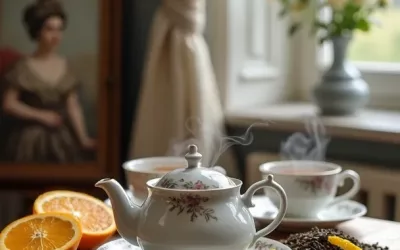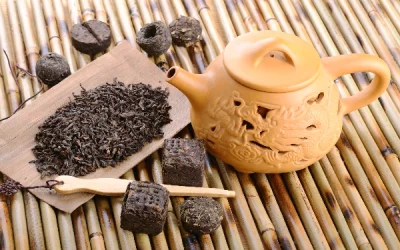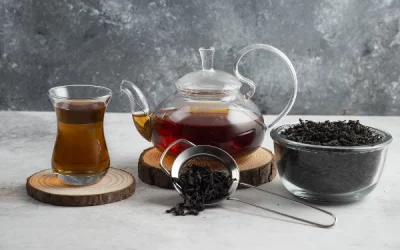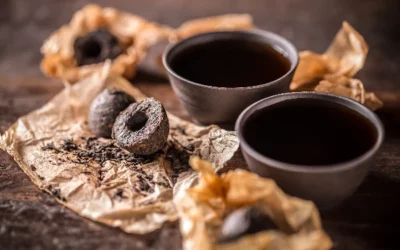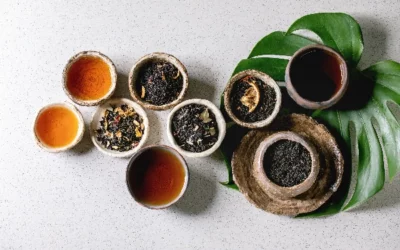Welcome, tea enthusiasts! If you’re eager to deepen your appreciation for the different types of black tea, you’ve come to the right place. In this guide, we’ll explore the rich history, production processes, and vibrant variety of black tea types, each with its own unique characteristics. Whether you’re curious about the malty depths of Assam, the floral elegance of Darjeeling, or the smoky intrigue of Lapsang Souchong, there’s so much to discover. Join me as we embark on this fascinating journey through the world of black tea—ready to expand your knowledge and tantalise your taste buds? Let’s dive in!
Table of Content
- What is black tea?
- What are the main types of black tea and their characteristics?
- What is Assam tea and why is it popular?
- What makes Darjeeling tea unique?
- How does Ceylon tea differ from other black teas?
- What are the characteristics of Keemun tea?
- Why is Lapsang Souchong tea known for its smoky flavor?
- What are the health benefits of black tea?
- Conclusion
What is black tea?
Black tea is a type of tea that is more oxidized than green, oolong, and white teas. It is made from the leaves of the Camellia sinensis plant. The oxidation process, which involves exposing the leaves to air, gives black tea its distinctive dark color and rich flavor. Here are some key points about black tea:
- Production Process: The production of black tea involves withering, rolling, oxidizing, and drying the tea leaves. The extent of oxidation distinguishes black tea from other types of tea.
- Varieties: There are several varieties of black tea, often named after the region where they are grown, such as Darjeeling and Assam from India, Ceylon from Sri Lanka, and Keemun from China.
- Flavor Profile: Black tea has a stronger flavor compared to green or white teas. It can be malty, fruity, spicy, or even smoky, depending on the region of cultivation and the processing method.
- Caffeine Content: Black tea generally contains more caffeine than green or white teas but less than coffee. The exact caffeine content can vary depending on the type of tea and how it is brewed.
- Health Benefits: Black tea is rich in antioxidants, such as flavonoids, which can help in reducing inflammation and may lower the risk of chronic diseases like heart disease. It is also known to support digestive health and improve focus and concentration.
- Consumption: Black tea can be enjoyed plain, with milk and sugar, or with lemon and honey. It is also the base for many flavored teas, such as Earl Grey and chai.
- Cultural Significance: Black tea plays an important role in various cultures around the world. For instance, it is a traditional beverage in countries like China, India, the United Kingdom, and Russia, each having its own unique preparation and serving methods.
Overall, black tea is a versatile and widely consumed beverage appreciated for its robust flavor and potential health benefits.
What is the history of black tea?
Black tea has a rich and captivating history that dates back to ancient China. During the Tang Dynasty, China primarily produced green tea. However, as trade expanded, the demand for a tea that could withstand long journeys without losing its quality led to the development of black tea. The British East India Company played a significant role in popularising black tea in Europe.
- Originated in China during the Tang Dynasty.
- Spread through trade routes across Asia and Europe.
- Gained popularity in Europe thanks to the British East India Company.
- Led to the cultivation of unique varieties like Earl Grey and English Breakfast.
- Today, black tea is grown and enjoyed worldwide.
The global tea trade fostered cross-cultural exchange and influenced tea-drinking customs. Each tea-growing region, such as Assam in India or Darjeeling in Nepal, offers distinct black tea variants that reflect local traditions and agricultural practices.
What are the stages of black tea production?
The production of black tea involves several intricate stages, each contributing to its distinctive flavour and aroma. Understanding these stages can enhance your appreciation of this versatile beverage.
- Withering: Leaves are spread out to dry, reducing their moisture content.
- Rolling: Leaves are rolled to release essential oils and juices.
- Oxidation: Leaves are exposed to air, allowing them to darken and develop flavour.
- Firing: Leaves are dried using heat to stop the oxidation process.
- Sorting: Leaves are sorted and graded based on size and quality.
Withering is the first step, where the leaves lose moisture and become pliable. Then, the rolling process breaks the leaves’ cell walls to release essential oils and juices. The oxidation process follows, during which the leaves are exposed to air and develop their characteristic dark colour and strong flavour. Finally, the leaves are dried to halt oxidation and sorted into various grades.
During the 18th century, the Scottish botanist Robert Fortune disguised himself and journeyed into remote Chinese tea plantations. He smuggled tea plants and seeds back to India, facilitating the British Empire’s efforts to cultivate tea. This bold endeavour significantly impacted the tea industry and marked the beginning of India’s robust black tea production.
What are the main types of black tea and their characteristics?
Black tea comes in a variety of types, each with its unique characteristics, flavours, and origins. Understanding the different types of black tea can help you choose the right one for your taste and expand your tea-drinking experience. Below is a comprehensive table that lists several prominent types of black tea, their regions of origin, their flavour profiles, and their unique characteristics.
| Type of Tea | Region of Origin | Flavour Profile | Unique Characteristics |
|---|---|---|---|
| Assam | India | Malty, robust | Strong, full-bodied, often used in blends like English Breakfast |
| Darjeeling | India | Floral, fruity | Often referred to as the “Champagne of teas,” has a light, muscatel flavour |
| Ceylon | Sri Lanka | Citrusy, brisk | Bright and bold, can vary from region to region within Sri Lanka |
| Keemun | China | Smoky, sweet | Smooth and often likened to wine, sometimes with a hint of pine |
| Lapsang Souchong | China | Smoky, pine | Traditionally smoked over pine wood fires, gives it a distinctive smoky aroma and taste |
| Yunnan | China | Earthy, peppery | Rich and complex with hints of chocolate and spice |
| Nilgiri | India | Fragrant, smooth | Smooth and fragrant, from the high-altitude Nilgiri hills in Southern India |
| Earl Grey | Blended/Various | Citrusy, bergamot | Black tea infused with natural bergamot oil, giving it a unique citrus fragrance |
Using this table can help you easily compare and contrast the key elements of various black teas:
- The Type of Tea column names each variety.
- The Region of Origin indicates where the tea is grown, which can affect its characteristics.
- The Flavour Profile provides a quick snapshot of the taste you can expect.
- The Unique Characteristics offer additional details that make each tea stand out.
How does region affect the flavour of black tea?
The region where a tea is grown has a significant impact on its flavour profile. Soil quality, climate, altitude, and traditional processing techniques all play a part in shaping the final taste of the tea. For example:
- Assam: This region experiences heavy rainfall and high humidity, contributing to the full-bodied, malty flavour of Assam tea.
- Darjeeling: The high-altitude gardens in this region, combined with the unique soil and climate, produce teas with a light, muscatel flavour that’s unlike any other.
- Ceylon: The diverse climates in Sri Lanka allow for a variety of Ceylon teas, from bold and brisk to more delicate and fragrant.
- China: The diversity of the Chinese landscape results in a wide range of flavours, from the smoky aromas of Lapsang Souchong to the sweet, smooth notes of Keemun.
Tea regions have unique attributes that influence the taste of the final product:
- Climate: Amount of sunlight, rainfall, and temperature.
- Soil: Mineral content, pH levels, and fertility.
- Altitude: Higher altitudes generally result in more complex flavours.
- Processing: Traditional methods used in each region to process the tea leaves.
Understanding these factors can enhance your appreciation for the subtle differences between each type of black tea. You’ll find that the terrain, weather conditions, and even the traditional practices of a tea-producing region contribute to the distinct characteristics of its teas.
What are some popular blends that use black tea?
Blending is also a fine art in the world of black tea. Many popular tea blends utilise different types of black tea to create unique and balanced flavour profiles. Some well-known blends include:
- English Breakfast: Typically a blend of Assam, Ceylon, and sometimes Kenyan teas, creating a robust and full-bodied brew.
- Irish Breakfast: This blend often contains a higher proportion of Assam tea, making it bolder and more malty than English Breakfast.
- Russian Caravan: A historic blend that includes Chinese black teas like Keemun and Lapsang Souchong, known for its smoky and sweet flavour.
- Masala Chai: An Indian blend combining black tea with aromatic spices such as cinnamon, cardamom, ginger, and cloves.
- Lady Grey: A milder version of Earl Grey, this blend includes additional citrus notes and sometimes a hint of lavender.
Popular blends offer a variety of flavour experiences:
- English Breakfast: Balanced, strong, pairs well with milk and sugar.
- Irish Breakfast: Malty, robust, perfect for a hearty start to the day.
- Russian Caravan: Smoky, sweet, an excellent choice for an evening tea.
- Masala Chai: Spicy, warming, commonly enjoyed with milk and sweetener.
- Lady Grey: Light, citrusy, a refreshing afternoon tea.
Blending different types of black tea can create a whole new palette of flavours, providing endless options for a delightful tea experience.
In the 18th century, Catherine the Great had a penchant for Russian Caravan tea, a smoke-laden blend that travelled the Silk Road. Its unique taste came from the pinewood fires over which the tea leaves dried. It was not just a beverage, but a diplomatic gift symbolising the strong ties between the Russian Empire and China. Each sip transported her court to distant lands, bridging cultures with its steaming essence.
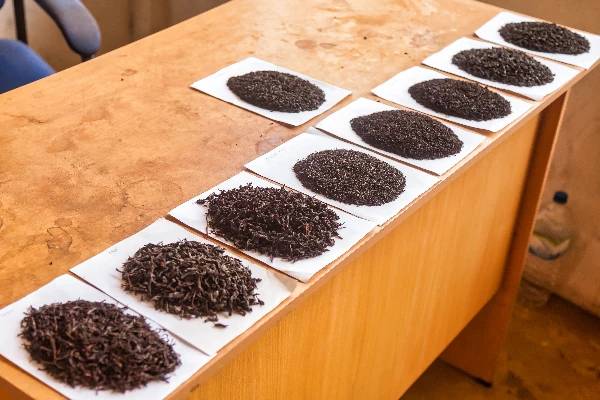
What is Assam tea and why is it popular?
Let’s take a quick dive into Assam tea. Straight from the northeastern state of Assam, India, this tea is the rock star of black teas. Why? Because it’s got everything a tea lover could ever dream of: a robust flavour, a hefty caffeine punch, and a history that reads like a gripping novel.
Where is Assam tea grown?
Assam tea hails from—wait for it—Assam! Shocking, right? This region, nestled in the lush valleys flanked by the Brahmaputra River, is one of the largest tea-producing areas in the world. If tea estates were celebrities, Assam estates would be A-listers.
- Location: Northeastern India
- Environment: Subtropical rainforest, heavy monsoon rains
- Altitude: Mostly low-elevation, which adds to its strength
- Perfect Conditions: High humidity and ideal temperatures
The combination of these factors makes Assam a unique terroir, contributing to the distinct characteristics of Assam tea.
What is the flavor profile of Assam tea?
You want to know what a kick in the taste buds feels like? Just try Assam tea. This brew packs a malty punch that is both smooth and invigorating.
- Malty Flavour: Strong and rich, almost like a liquid biscuit
- Robust and Full-Bodied: Feels like a warm hug in a cup
- Colour: Deep amber, almost like a sunset in a glass
- Aromas: Malt, earth, and just a hint of sweetness
- Astringency: Balanced, with just the right amount of zing to keep you going
Thanks to these attributes, Assam tea is a popular choice for those who enjoy a strong cup in the morning. It’s like the coffee of the tea world, but without the jittery aftermath.
Why is Assam tea popular?
Why is Assam Tea the Ryan Reynolds of the tea world? Because it’s versatile, packs a punch, and leaves everyone wanting more.
- Breakfast Tea Staple: Ever heard of English Breakfast Tea? Yep, that’s Assam stealing the show.
- Blends Well: Whether you like it on its own or mixed, it plays nicely with others.
- High Caffeine Content: Perfect for jumping out of bed and conquering the day.
- Affordable: High-quality yet doesn’t break the bank.
- Mass Production: Easy to find and available worldwide.
Thanks to its quality and versatility, Assam tea easily finds its way into breakfast blends and remains a staple in many homes.
There’s a nugget of history here that makes Assam tea even more fascinating. Back in the 19th century, the British East India Company was looking for an alternative to Chinese tea. Lo and behold, they discovered the Assam plant, Camellia sinensis var. assamica, thriving in the Indian subcontinent. This discovery not only revolutionised the British tea industry but also transformed Assam into a global tea powerhouse. So, the next time you sip on your cup of Assam, remember, you’re not just drinking tea; you’re tasting a historic revolution in a cup.
And there you have it—Assam tea, in all its robust, malty, and historically rich glory. Drink up! You’re now part of a storied tradition.
What makes Darjeeling tea unique?
Alright, tea enthusiasts, let’s talk about Darjeeling tea – also known as the ‘Champagne of Teas’. That’s right, tea so fancy it’s practically asking for a monocle and fake British accent. So what makes this tea so special? Spoiler: it’s not just marketing fluff.
Darjeeling tea hails from the Darjeeling region in West Bengal, India, which is nestled in the foothills of the Himalayas. Think rolling hills, misty air, and a touch of magic – it’s like the Hogwarts of tea-growing regions. This area is cool and high-up, which works wonders for the tea plants. The tea itself offers a unique, light, and floral flavour that sets it apart from its more robust black tea cousins (looking at you, Assam!).
The terrain, altitude, and peculiar climate of Darjeeling contribute to something called “seasonal flushes.” No, it’s not a British way of saying seasonal colds. Flushes are the periods when tea is harvested – each with its own distinct taste. Added to that, Darjeeling tea uses a specific grading system that identifies the quality of tea leaves.
Now, let’s dive deeper.
What is the flavor profile of Darjeeling tea?
Imagine taking a sip of liquid sunshine, sprinkled with a hint of flowers, a whisper of fruit, and a delicate note of spice. That’s Darjeeling tea, folks! Whether:
- Light and floral in its first flush
- Full-bodied in its second flush
- Autumnal in its final flush
this tea is always a delight to your taste buds.
The light and floral taste come from the tea plants basking in high-altitude coolness, reminiscent of how happy cows make better milk. Hence, Darjeeling tea is softer and less astringent compared to something like Ceylon tea. Flavour-wise, think of:
- Muscatel notes (fancy talk for a grape-wine-like flavour)
- Mild astringency that balances the sweetness
- Nutty undernotes often found in the later flushes
- Citrusy brightness, especially in the early flushes
What are the different seasonal flushes of Darjeeling tea?
Let’s break it down by flushes. One may wonder if tea is growing or attending Hogwarts, given how “flushes” sound like something out of a magical curriculum. Here’s the scoop:
- First Flush (Spring Flush): Harvested in late March; light in colour and flavour, orchestrating a symphony of floral and fruity notes.
- Second Flush (Summer Flush): Harvested from May to June; richer and fuller – here comes the muscatel flavour which makes sommeliers weep with joy.
- Monsoon Flush: Harvested during the rainy season; generally less prized due to its strong and less nuanced taste.
- Autumn Flush: Harvested from October to November; warmer and more mature flavour profile, bridging the gap between floral and earthy.
Each flush captures a snapshot of Darjeeling’s seasonal palette, making it a tea that has an evolution through the year.
Why is Darjeeling tea called the ‘Champagne of Teas’?
Calling Darjeeling tea the ‘Champagne of Teas’ is not just a marketing gimmick – although it does sound impressively posh. Simply put, it’s the exclusive nature and superior quality of the tea. Let’s break down why it earns this title:
- Geographical Indication: Just like Champagne, Darjeeling can only be called Darjeeling if it comes from the Darjeeling region. It’s the law!
- Complexity of Flavour: The nuanced layers of taste are akin to fine wine. Each sip can reveal new facets – muscatel, floral, fruity, or nutty.
- Limited Production: High demand and limited supply elevate its status. Much like your patience on Monday mornings, this tea is rare and precious.
- Reputation: Centuries of craftsmanship and tradition bolster its prestige. People who drink it like to remind you of their impeccable taste in tea.
Darjeeling has a charm that stands the test of time. Just like Napoleon Bonaparte’s fondness for tea stood out; even during exile on Saint Helena, he ensured a steady supply of his favourite drink. Historical figures knew the value of good tea – and Darjeeling leads that legacy, one aromatic cup at a time.
So next time you sip on Darjeeling, remember you’re drinking the choice of champions (and emperors).
How does Ceylon tea differ from other black teas?
Buckle up, tea enthusiasts! Let’s dive into the world of Ceylon tea and find out what makes this black tea stand out from its leafy peers. This journey will take us to Sri Lanka, the tropical island paradise where Ceylon tea is grown. With its bright and coppery color and full-bodied flavor, Ceylon tea has some unique characteristics that set it apart from other black teas.
As you sip your way through this discussion, here’s what you’ll discover: the intricate details about the origin of Ceylon tea, its distinct flavor profile, and the unique tea processing methods used in Sri Lanka.
Where is Ceylon tea grown?
Ceylon tea is grown in the lush, rolling hills of Sri Lanka, formerly known as Ceylon (hence, the name). This small island packs a punch when it comes to tea production. The diverse climates and elevations across the island contribute to the unique characteristics of Ceylon tea.
When it comes to Sri Lankan tea regions, they are divided into three main areas:
- Low-grown regions: Located closer to sea level, these areas produce tea with a strong, robust flavour.
- Mid-grown regions: Situated at elevations between 2,000 and 4,000 feet, these areas yield tea with a balanced and mild flavour.
- High-grown regions: Nestled above 4,000 feet, these high-altitude areas produce tea with a delicate and floral aroma.
The tea-processing methods in Sri Lanka play a crucial role, too. The leaves undergo orthodox processing, which preserves their natural flavours and aromas, making each cup of Ceylon tea a delightful experience.
What is the flavor profile of Ceylon tea?
Now, let’s talk about the flavour. If you think all black teas taste the same, think again. Ceylon tea boasts a flavour profile that’s truly its own.
- Bright and coppery colour: It’s not just the taste but also the visual appeal that sets Ceylon tea apart.
- Full-bodied flavour: This tea is known for its rich, full-bodied taste that can range from brisk and citrusy to bold and malty, depending on the region and altitude where it’s grown.
- Aroma: You’ll often find a delightful balance of floral, fruity, and spicy notes, making each sip an aromatic adventure.
- Versatility: Ceylon tea can be enjoyed plain, with milk, or with a splash of lemon – it’s that adaptable!
So, whether you’re in the mood for a strong morning pick-me-up or a gentle afternoon tea, Ceylon tea’s diverse flavour profile has got you covered.
How does Ceylon tea differ from other black teas?
Now that you’re familiar with where Ceylon tea is grown and its distinct flavour profile, let’s see how it stacks up against other black teas.
- Origin: Unlike Assam tea from India or Darjeeling tea from the Himalayan foothills, Ceylon tea comes from Sri Lanka, giving it a unique terroir.
- Colour: While Assam tea is known for its dark, robust liquor, and Darjeeling tea boasts a lighter, golden hue, Ceylon tea strikes a balance with its bright and coppery appearance.
- Flavor: Ceylon tea offers a versatile range of flavours, from brisk and citrusy to bold and malty, whereas Assam tends to be rich and malty and Darjeeling, delicate and floral.
- Processing: The traditional orthodox processing method in Sri Lanka is key to retaining the nuanced characteristics of Ceylon tea, unlike the often CTC (crush, tear, curl) method used for Assam tea that results in a more uniform taste.
- Regions: The diverse climates and elevations in Sri Lanka give Ceylon tea its unique and varied characteristics, whereas other black teas might not have such a broad spectrum of regions and flavours.
So, if you’re looking to expand your tea horizons, Ceylon tea offers a delightful exploration into the world of black teas, with flavours and aromas that are distinctively its own.
Now, let’s dive back in time to add a little spice to our tea story. Picture this: it’s the 19th century, and a British gentleman named James Taylor steps foot on Sri Lankan soil. Armed with a green thumb and a love for tea, Taylor transforms the landscapes of Sri Lanka into thriving tea plantations. His efforts didn’t just boost Sri Lanka’s economy; they introduced the world to the unique delights of Ceylon tea. And there you have it – a brew that not only warms your cup but also carries a legacy of dedication and passion.
What are the characteristics of Keemun tea?
Keemun tea, often hailed as the Burgundy of teas, offers an intricate flavour profile that keeps tea enthusiasts coming back for more. But what makes this Chinese black tea so darn special? Spoiler alert: it’s smooth, fruity, and versatile enough to blend with. Let’s dive into the nitty-gritty, shall we?
First off, Keemun hails from the Qimen County in the Huangshan City of Anhui Province, China. Yes, it’s got that fancy geographical tag because only tea from this region can wear the Keemun badge of honour. This area boasts the perfect climate and soil conditions that gift Keemun tea its unique characteristics.
The magic begins with its smooth texture and fruity undertones. Think of biting into a ripe plum while lounging on satin sheets. Add in a hint of smoky aroma and a whiff of orchids, and you have yourself a cup of Keemun. The flavour is so balanced that it stands alone proudly but also gets along swimmingly in a blend — kinda like the tea version of a social butterfly.
But it’s not just the taste; the aroma is a game-changer. It’s got this earthy smell that just makes you want to breathe in your tea before you even bother sipping it. Plus, it doesn’t hurt that it’s relatively low in tannins, making it less astringent compared to other black teas. Ready for a deep dive into more geeky details? Buckle up!
Where is Keemun tea grown?
Keemun tea is exclusively grown in Qimen County, a region in the Huangshan City of Anhui Province, China. This area is as picturesque as it sounds, adorned with rolling hills and misty landscapes. The subtropical monsoon climate does wonders for the tea leaves. Talk about environmental perks!
- Location: Qimen County, Huangshan City, Anhui Province, China.
- Climate: Subtropical monsoon with mild temperatures and abundant rainfall.
- Soil: Rich and fertile, ideal for cultivating high-quality tea.
- Altitude: Typically grown at elevations ranging from 100-300 meters.
- Harvest Seasons: Primarily in spring and summer, with the best leaves picked from April to June.
It’s fascinating to know that even slight variations in climate or soil quality can significantly impact the flavour profile of Keemun tea. So, next time you sip on a cup, you can thank Qimen County’s unique terrain for that sublime experience.
What is the flavour profile of Keemun tea?
Describing the flavour profile of Keemun tea is like trying to describe a symphony to someone who’s never heard music. But let’s give it a shot. This tea is smooth, with notes of fruit and a smoky undertone that feels like a warm hug. And the aroma? Simply heavenly.
- Fruity Notes: Hints of plum, apricot, and sometimes even hints of wine.
- Smoky Undertone: A subtle smokiness that complements the fruity flavours.
- Smooth Texture: No harsh tannins, making it smooth and silky.
- Earthy Aroma: A rich, earthy smell often with floral hints like orchids.
- Balanced Flavour: Neither too strong nor too weak, just the right amount of boldness.
The combination of these elements results in a tea that’s complex enough for connoisseurs but accessible for those new to black teas. Its unique mix of flavours and aromas certainly sets it apart from the crowd.
Why is Keemun tea a preferred choice for tea blending?
Keemun tea is the Swiss Army knife of black teas when it comes to blending. Its smooth and balanced flavour makes it compatible with various other teas and ingredients. Look out Earl Grey; Keemun’s versatility might just steal your thunder.
- Smooth Texture: Its low tannin content ensures it doesn’t overpower other teas.
- Rich Flavour: Adds depth without being too dominant.
- Adaptability: Works well with a range of flavours, from citrus to spices.
- Complementary Aroma: Its earthy and floral notes pair wonderfully with other aromas.
- Popularity: It’s a sought-after choice in many classic blends, enhancing the overall experience.
This ability to get along with others makes Keemun tea a favourite among blenders looking to create a harmonious brew. Whether it’s adding robustness to a breakfast blend or bringing complexity to a flavoured tea, Keemun is the go-to player.
Once upon a time, tea-drinking Brits discovered Keemun tea. In the 19th century, it quickly gained popularity due to its unique taste and aroma. Queen Victoria herself allegedly always had a stash of Keemun in her royal pantry. So the next time you’re savouring a cup, know you’re sipping on a tea fit for royalty!
Why is Lapsang Souchong tea known for its smoky flavor?
Ah, Lapsang Souchong. If regular black tea is the dorky cousin, this one’s the rebellious rockstar with a penchant for bonfires. Known for its signature smoky taste, it’s the drink that makes you wonder if you’re sipping on tea or inhaling a campfire. Intriguing, right? Let’s dive deep into the smoky abyss to uncover the secrets behind Lapsang Souchong.
Alright, so first off, Lapsang Souchong originates from the Wuyi Mountains in the Fujian province of China. Think of this place as the tea equivalent of Hollywood for actors—where the magic happens. The region is famous for its rocky terrain and cloudy atmosphere, perfect for crafting teas with unique flavour profiles.
The smoky hit you get from Lapsang Souchong? That’s not just some marketing gimmick. It’s achieved through a rather old-school method. First, the tea leaves are withered over pinewood fires. Then, they’re rolled and oxidized before being roasted in bamboo baskets over—you guessed it—pinewood fires. It’s like giving your tea a good old smoking session.
You think tea is only meant for sipping? Think again. Lapsang Souchong adds a smoky twist to culinary dishes too. From broths to marinades, it’s the tea that thinks it’s a spice. Imagine infusing your favourite dish with a subtle smoky aroma. Fancy, eh?
What is the origin of Lapsang Souchong tea?
Picture a foggy mountain range, shrouded in a cloak of mist. That’s the Wuyi Mountains for you. Nestled in Fujian province, this region is the birthplace of Lapsang Souchong. It’s like the Hogwarts of black tea—ancient, mysterious, and enchantingly unique. This tea has been serenading tea enthusiasts since the Qing Dynasty era.
- Region: Wuyi Mountains, Fujian Province, China
- Known For: Rugged terrain and misty atmosphere
- Historical Roots: Qing Dynasty era
- Unique Ecosystem: Perfect for unique tea profiles
- Cultural Significance: Revered and traditional
Lapsang Souchong’s roots reach deep into Chinese tea culture, making it as old as some of the scrolls in your grandma’s attic. The region’s climate aids in cultivating tea leaves that are bold and aromatic.
How is the smoky flavor of Lapsang Souchong tea achieved?
Wondering how this tea gets its signature smoky flavour? Let’s pull back the curtain. The magic ingredient here is pinewood smoke. It’s not rocket science, but it is pretty darn close to alchemy. Here’s how it works: freshly plucked tea leaves are first withered over pinewood fires, then rubbed down like they just ran a marathon. After that, they’re roasted in bamboo baskets over—you guessed it—pinewood fires again. Talk about a smoky spa treatment for your tea leaves!
- Withering: Over pinewood fires
- Rolling: To release essential oils
- Oxidation: Mature the flavours
- Roasting: In bamboo baskets over pinewood fires
- Final Touch: Smoky aroma infused
This dual-smoking process not only gives the tea its characteristic flavour but also preserves it for longer periods. It’s like two birds, one stone—except the birds are smoky flavour and longevity.
What are some culinary uses of Lapsang Souchong tea?
Who said tea is only for sipping? With its smoky flavour, Lapsang Souchong is a culinary multi-tasker. From adding depth to broths and sauces to stepping up your marinade game, it’s the kitchen’s unsung hero.
- Broths: Adds complexity to soups and stews
- Marinades: A smoky touch for meats and veggies
- Sauces: Enhances BBQ sauces and gravies
- Baking: Incorporate into cakes and cookies for a unique twist
- Cocktails: Smoky flair for your evening drink
Think of it as the secret ingredient that nobody sees coming but everybody remembers. Ever thought of adding a smoky dimension to your BBQ sauce? Go ahead, impress your mates.
Once upon a time in the misty Wuyi Mountains, a group of tea farmers found themselves with a batch of tea leaves and no means to dry them due to an urgent retreat from advancing soldiers. Necessity, being the mother of invention, led them to dry the leaves over pinewood fires. When the smoke cleared, a new flavour profile emerged, one that would soon become legendary. It’s like stumbling upon gold while digging for carrots.
This accidental mastery gave birth to the iconic Lapsang Souchong, proving once again that sometimes the best things in life are happy accidents.
What are the health benefits of black tea?
Ah, black tea. The potion that fuels our mornings and tackles our midday slumps. But beyond being a daily energiser, it’s also packed with various health benefits. I’m talking about antioxidants that fight off those pesky free radicals, heart health perks that might just make you fall in love with it even more, improvements in digestive health, a kick to your mental alertness that coffee could only dream of, and even some assistance in the weight management department. Let’s dig a bit deeper, shall we?
What antioxidants are found in black tea?
Antioxidants: they’re like the bouncers of the nutrition world, kicking out the harmful free radicals that try to crash your cellular party. Black tea is loaded with these protectors. Here’s a rundown:
- Flavonoids: These bad boys help protect your cells from damage.
- Theaflavins: Formed during the fermentation process, they boast anti-inflammatory properties.
- Phytonutrients: These naturally-occurring chemicals pack a punch against oxidative stress.
- Catechins: While less abundant in black tea than green tea, they contribute to the antioxidant power.
- Quercetin: An antioxidant that supports heart health and has anti-allergic properties.
These antioxidants work together to protect your cells, fight inflammation, and keep you feeling like a boss.
How does black tea benefit heart health?
The heart wants what it wants—and apparently, it wants black tea. Studies have shown that drinking this magical brew can help improve cardiovascular health in several ways:
- Reduced cholesterol: Black tea can lower LDL cholesterol, the “bad” kind.
- Improved blood pressure: Regular consumption might help in keeping the blood pressure balanced.
- Blood circulation: Flavonoids in black tea improve circulation, reducing the risk of stroke.
- Anti-inflammatory: Black tea’s theaflavins help keep inflammation, which is linked to heart disease, in check.
- Antioxidants: As mentioned, these can prevent damage to blood vessels.
Sip, sip, hooray for a healthier heart.
Can black tea aid in weight management?
Yes, indeed! Black tea might not turn you into a gym junkie, but it has some weight management quirks up its sleeve:
- Boosts metabolism: The caffeine jolt can speed up your metabolic rate, helping you burn more calories.
- Reduces appetite: Drink a cup of black tea and you might find yourself less inclined to snack.
- Improves fat distribution: The compounds in black tea can help reduce overall fat absorption.
- Gut health: Promotes healthy gut bacteria, which can play a role in weight management.
- Low-calorie drink: Unless you dump sugar into it, it’s naturally low in calories.
So, skimp on the sugar and let black tea help you manage that waistline.
In case you need a historical anecdote to impress your friends over tea, let’s talk about the Boston Tea Party of 1773. No, it wasn’t a quaint gathering of tea enthusiasts but rather a significant event that set the stage for the American Revolution. American colonists, miffed about the Tea Act imposed by the British Parliament, dumped an entire shipment of tea into the Boston Harbor.
While the event was a protest, it inadvertently shone a spotlight on the importance of tea in society. It’s an interesting tidbit to share while sipping your antioxidant-loaded black tea and considering its vast health benefits. Cheers to history and to health!
Conclusion
As I reflect on the rich tapestry of black tea, it becomes evident that this beloved beverage is much more than just a drink; it’s a historical journey wrapped in tradition. Throughout this guide, we’ve explored the essentials of black tea, tracing its origins and the meticulous processes that transform the freshest leaves into the comforting cups we savour. From understanding how the withering, rolling, oxidation, and firing processes shape its character, to delving into the diverse types of black tea—from the robust Assam to the delicate Darjeeling, the vibrant Ceylon, and the intriguing Lapsang Souchong—it’s clear that each variety offers a unique experience that reflects its terroir.
This exploration reveals the importance of appreciating not just the flavour but the distinct cultural significance of these teas across different regions. The health benefits of black tea add yet another layer to our understanding, underscoring its role not only as a delightful beverage but also as a conduit for wellness. In an age where mindfulness and health intertwine, recognising the positive impacts of black tea, such as its antioxidants and contributions to heart health, encourages us to incorporate it more thoughtfully into our daily routines.
As I conclude, I urge my fellow tea enthusiasts to step beyond the usual blends and explore the many varieties of black tea available. An elegant or hearty cup awaits, and each sip invites a deeper connection to the world from which it came. Which type of black tea resonates most with you, and how does it enhance your daily rituals? The beauty of tea lies in its endless exploration, so pour a cup, and let your journey begin.


